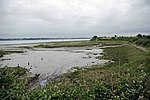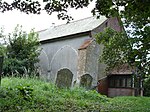Oakfield Wood
Essex Wildlife Trust

Oakfield Wood is a 2.8-hectare (6.9-acre) nature reserve west of Wrabness in Essex. It is managed by the Essex Wildlife Trust.This is former farmland which is being converted into a "green burial ground", overlooking the Stour Estuary. A native broadleaved tree is planted for each burial with a wooden plaque at the base. When the burial ground is full, it will be managed by the trust as a nature reserve.There is access to the site carpark from Wheatsheaf Lane by a track which leads through Wrabness Nature Reserve carpark.
Excerpt from the Wikipedia article Oakfield Wood (License: CC BY-SA 3.0, Authors, Images).Oakfield Wood
Wheatsheaf Close, Essex
Geographical coordinates (GPS) Address Nearby Places Show on map
Geographical coordinates (GPS)
| Latitude | Longitude |
|---|---|
| N 51.94 ° | E 1.151 ° |
Address
Wheatsheaf Close
CO11 2TD Essex
England, United Kingdom
Open on Google Maps







